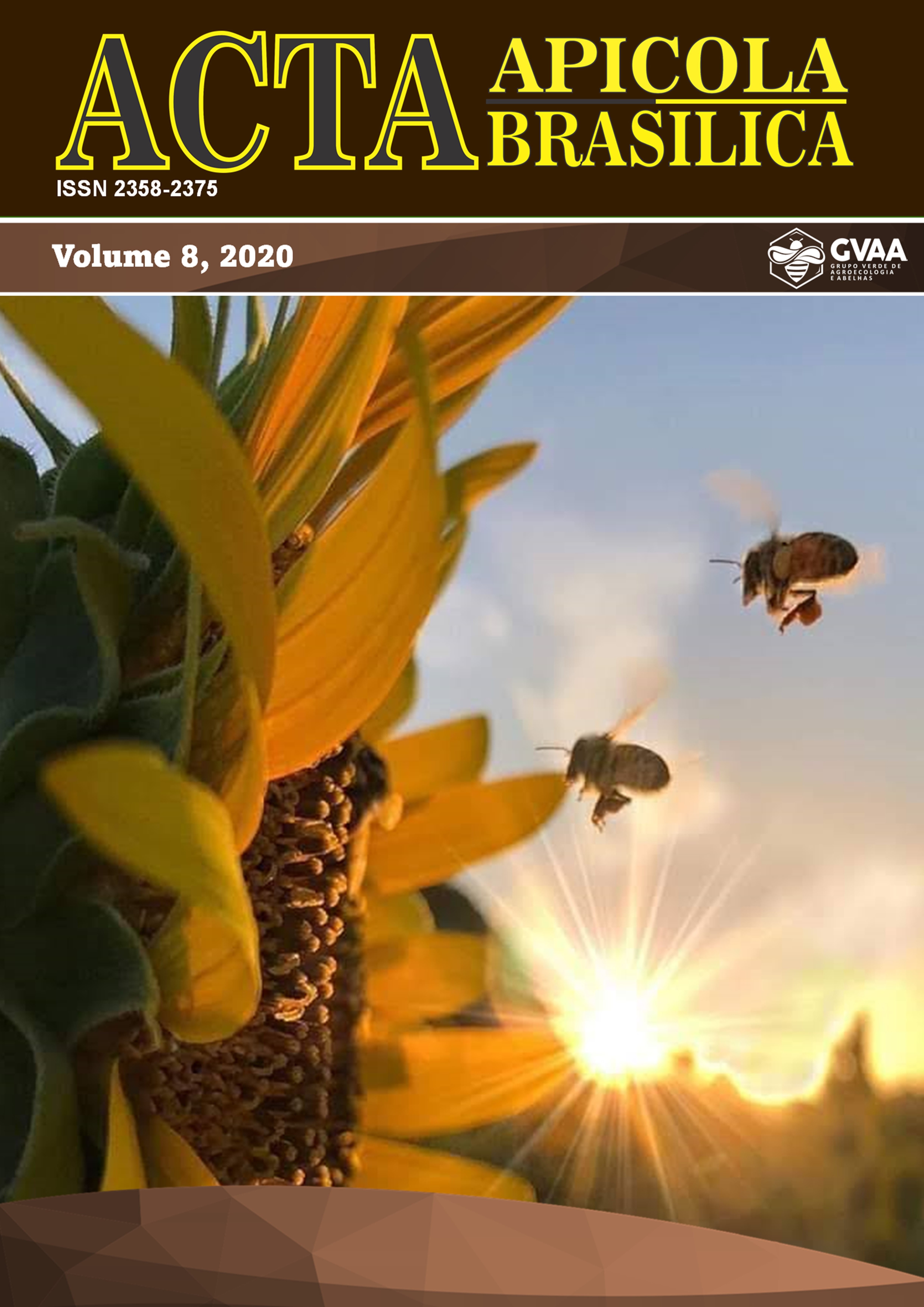Weight and storage capacity of the stomach africanized honeybees in southern Santa Catarina, Brazil
DOI:
https://doi.org/10.18378/aab.v8i0.7989Keywords:
Apis mellifera, Colony, ConsumptionAbstract
The objective of this study was to evaluate worker honey bees weight and the capacity of the honey vesicle of africanized Apis mellifera L. in the southern region of Santa Catarina. The honeybees were conditioned in pots to measure their weights and, subsequently, honey was supplied until satiety and heavy for the quantification of the stomach capacity. ,. The average weight of Africanized honey bees was 76.20 ± 10.33 mg. The mean stomach capacity was 24.50 ± 12.69 mg. The low coefficient determination regression equation (r2 = 0.03998) demonstrating variability between stomach capacity and weight Africanized honey bees. The weight and capacity of the honey vesicle of bees in the southern region of Santa Catarina is 76.20 mg and 24.50 mg, respectively.Downloads
References
ALFALAH, H.A.; SHAIBI, T.; TAWFIQ, M. M.; MOGRBY, A.A. The effects of wax comb age on some morphometrics characteristics of honey bee (Apis mellifera L.) workers. Persian Gulf Crop Protection, v.1, n.1, p.18-23, 2012.
BRODSCHNEIDER, R.; CRAILSHEIM, K. Nutrition and health in honey bees. Apidologie, v.41, p.278-294, 2010. DOI: https://doi.org/10.1051/apido/2010012
CHOLE, H.; WOODARD, S. H.; BLOCH, S. Body size variation in bees: regulation, mechanisms, and relationship to social organization. Current Opinion in Insect Science. v.35, p.77-87. 2019. DOI: https://doi.org/10.1016/j.cois.2019.07.006
COOK, S. C. Compound and dose-dependent effects of two neonicotinoid pesticides on honey bee (Apis mellifera) metabolic physiology. Insects, v.10, n.18, 2019. DOI: https://doi.org/10.3390/insects10010018
CRANE, E. O livro do mel. São Paulo: Editora Nobel, 1987. 226p.
CRUZ-LANDIM, C. Morfologia e função de sistemas. São Paulo: Editora UNESP, 2009. 408p. DOI: https://doi.org/10.7476/9788539304301
HAMMER, Ø. PAST - Paleantológical statistcs. Version 3.20. 2018. Disponível em: <https://folk.uio.no/ohammer/past/> . Acesso em: 15 dez. 2018
LEE, P. C.; WINSTON, M. L. The influence of swarm size on brood production and emergent worker weight in newly founded honey bee colonies (Apis mellifera L.). Insectes Sociaux, v.32, n.1, p.96-103, 1985. DOI: https://doi.org/10.1007/BF02233230
NOGUEIRA-COUTO, R. H.; COUTO, L. A. Apicultura: manejo e produtos. Jaboticabal: FUNEP, 2006. 193p.
OKUYAN, S.; AKYOL, E. The effects of age and number of grafted larvae on some physical characteristics of queen bees and acceptance rate of queen bee cell. Turkish Journal of Agriculture - Food Science and Technology, v.6, n.11, p.1556-1561, 2018. DOI: https://doi.org/10.24925/turjaf.v6i11.1556-1561.1955
OTIS, G. W.; WINSTON, M. L.; TAYLOR-JR, O. R. Engorgement and dispersal of Africanized honeybee swarms. Journal of Apicultural Research, v.20, n.1, p.3-12, 1981. DOI: https://doi.org/10.1080/00218839.1981.11100464
OTIS, G.W. Weights of worker honeybees in swarms. Journal of Apicultural Research, v.21, n.2, p.88-92, 1982. DOI: https://doi.org/10.1080/00218839.1982.11100520
PAULINO, F.D.G. Alimentação em Apis mellifera L.: exigências nutricionais e alimentos. In: 1º Simpósio de Nutrição e Alimentação Animal realizada na XIII Semana Universitária da Universidade Estadual do Ceará – UECE. 2007.
RUSSEL, S.; BARRON, A. B.; HARR, D. Dynamic modelling of honey bee (Apis mellifera) colony growth and failure. Ecological Modelling, v.265, p.158-169, 2013. DOI: https://doi.org/10.1016/j.ecolmodel.2013.06.005
SAMMATARO, D.; CICERO, J. M. Functional morphology of the honey stomach wall of the european honey bee (Hymenoptera: Apidae). Annals of the Entomological Society of America, v.103, n.6, p.979-987, 2010. DOI: https://doi.org/10.1603/AN09111
SAUTHIER, R.; PRICE, R.A.; GRÜTER, C. Worker size in honeybees and its relationship with season and foraging distance. Apidologie, v.48, p.234-246, 2017. DOI: https://doi.org/10.1007/s13592-016-0468-0
SNODGRASS, R. E. Anatomy of the honey bee. London: Cornell University Press, 1956. 334p.
SOUZA, D. A.; HUANG, M. H.; TARPY, D. R. Experimental improvement of honey bee (Apis mellifera) queen quality through nutritional and hormonal supplementation. Apidologie, v.50, n.1, p.14-27, 2019. DOI: https://doi.org/10.1007/s13592-018-0614-y
TAUTZ, J. The buzz about bees. Berlin: Springer, 2009. 288p. DOI: https://doi.org/10.1007/978-3-540-78729-7
TOTH, A. L.; ROBINSON, G. Worker nutrition and division of labour in honeybees. Animal Behaviour, v.69, n.2, p.427-435, 2005. DOI: https://doi.org/10.1016/j.anbehav.2004.03.017
VAUDO, A. D.; TOOKER, J. F.; GROZINER, C. M.; PATCH, H. M. Bee nutrition and floral resource restoration. Current Opinion in Insect Science, v.10, p.133-141, 2015. DOI: https://doi.org/10.1016/j.cois.2015.05.008
WINSTON, M. L. The biology of the honey bee. Cambridge: Harvard University Press, 1991. 276P.
WRIGHT, G. A.; NICOLSON, S. W.; SHAFIR, S. Nutritional physiology and ecology of honey bees. Annual Review of Entomology, v.63, p.327-344, 2018. DOI: https://doi.org/10.1146/annurev-ento-020117-043423
ZAKARIA, M. E. The physiological structure differences of the honey stomach tissue at different developmental stages of worker honey bees (Apis mellifera L.). Journal of Applied Sciences Research, v.6, n.1, p.45-49, 2010.
ZHENG, H.; POWELL, J. E.; STEELE, M. I.; DIETRICH, C.; MORAN, N. A. Honeybee gut microbiota prometes host weight gain via bacterial metabolism and hormonal signaling. PNAS, v.114, n.18, p.4775-4780, 2017. DOI: https://doi.org/10.1073/pnas.1701819114
ŻÓŁTOWSKA, K.; FRĄCZEK, R.; LIPIŃSKI, Z. Hydrolases of developing worker brood and newly emerged worker of Apis mellifera carnica. Journal of Apicultural Science, v.55, n.1, p.27-37, 2011.
Published
How to Cite
Issue
Section
License
Copyright (c) 2020 Lucas Almeida da Silva et al.

This work is licensed under a Creative Commons Attribution 4.0 International License.













